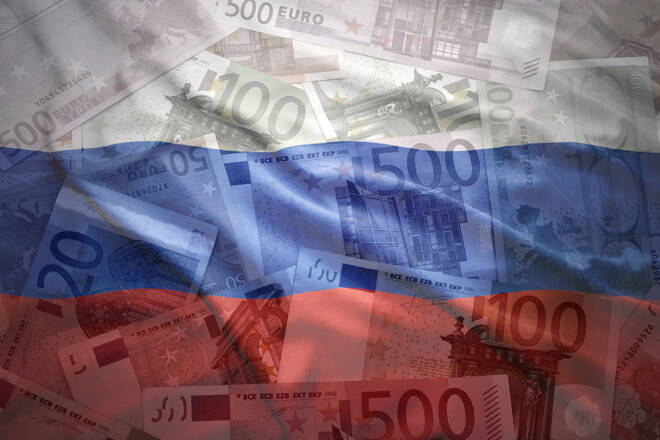Advertisement
Advertisement
Russia: Record Current Account Surplus Disguises Longer-term Impact of Economic Sanctions
By:
Russia recorded its highest current account surplus of the post-Soviet era due to the surge in energy prices. Far from pointing to the economy’s resilience, the data hide longer-term risks.
In this article:
Russia’s current account surplus – a broad measure of the country’s trade, investment earnings and transfer payments with the rest of the world – widened to USD 58.2bn in Q1 2022 (Figure 1), equivalent to nearly 10% of the Central Bank of Russia (CBR)’s USD 609bn of international reserves as of 8 April (including sanctioned and frozen reserves), which are down from a record high of USD 643bn on 18 February, before the full-scale invasion.
The wider surplus reflects soaring revenue from Russia’s oil and gas exports – largely spared from international sanctions for the present.
Figure 1. Russia recorded its highest ever current account surplus since at least 1994
Absent broader EU sanctions, Russia’s current account surplus could end the year above USD 200bn
Without broader EU sanctions of Russian oil and gas, Russia’s current account surplus could end the year well above USD 200bn, up from about USD 120bn in 2021, due to collapse of imports and the surging value of its commodity exports. This would essentially enable the CBR to rebuild a large segment of international reserves that sanctions have frozen.
Russia will speed up “de-dollarisation” of its reserves and foreign trade, including via increasing its exposure to Chinese renminbi, while maintaining exposure to euro. Russia currently conducts trade with China more in euro than in dollar, with EUR being the settlement currency with respect to half of Russian exports to China, compared with around one-third for USD.
We are yet to see the full impact of sanctions on the Russian economy
However, we are yet to see the full impact of sanctions and resulting consequences of the war on Russian foreign trade and the domestic economy, even if there is no near-term oil or gas embargo. First, sanctions are leading to a painful adjustment of imports for the Russian private sector, disrupting more than half of imported high-tech goods as well as a significant segment of imported machinery and equipment key for industrial production.
A loss of access to foreign technology weakens Russia’s already moderate medium-run growth potential, which we had estimated of around 1.5%-2% annually before the war’s escalation, while we expect Russian GDP to contract by at least 10% this year.
Secondly, an acceleration of European efforts to diversify energy imports away from Russia exacerbate medium-run economic challenges given lack of an ambitious government policy addressing the economy’s reliance on its energy export sector. The EU, which is, overall, Russia’s largest trading partner, recorded imports of Russian petroleum, natural gas and other related products of EUR 100bn last year. The EU’s plan to shed its dependence on Russian gas by 2030 could be brought forward – driven by German ambition to substantially cut dependence by 2024 – via diversification of gas supplies through increased liquefied natural gas and pipeline imports from non-Russian sources.
Full substitution of Russian energy exports to Europe is out of reach near term
We expect to see an acceleration of Russian efforts to counteract European measures partly through greater energy cooperation with China. Full substitution, however, is out of reach any time soon.
Importantly, today Russia does not have the infrastructure capacity to redirect pipeline gas from its west to the east. The capacity of Russia’s eight pipelines suppling gas to Europe is circa 220bcm/year, nearly six times that of its one pipeline to China, Power of Siberia, which is not operating at full capacity and is expected to reach only 38bcm/year by 2025.
In February 2022, Russia signed a 25-year agreement with China for supply of a further 10bcm of natural gas per year. Additionally, Russia is currently planning to develop the Power of Siberia-2 pipeline to deliver an extra 5 bcm/year of gas to China. The construction of the pipeline, however, is expected to conclude only by 2030.
Under this context, Russia’s demand to so-called “unfriendly countries”, including EU member states, to exchange dollar and euro for rouble to pay for Russian gas via a Russian bank reflects extension of a strategy to curtail reliance on western financial systems. This seeks to reduce risks to the Russian economy should accumulated gas revenues become subject to western sanctions in the future.
For a look at all of today’s economic events, check out our economic calendar.
Levon Kameryan is Senior Analyst in Sovereign and Public Sector ratings at Scope Ratings GmbH.
About the Author
Levon Kameryancontributor
Levon graduated with a M.Sc. in International Economics and Public Policy from the University of Mainz in 2016. Levon worked previously as an economist at the Central Bank of Armenia.
Latest news and analysis
Advertisement
